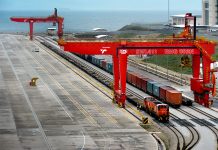
Carbon trading in the maritime sector was launched on 1 January, but the effects of the EU Emissions Trading System (EU ETS) have been amplified by the critical nature of the Red Sea attacks.
Last month’s missile and drone attacks on vessels transiting the narrow Bab al-Mandeb straits, where the Red Sea meets the Gulf of Aden and the Indian Ocean, have forced many vessels to divert onto the much longer route around the Cape of Good Hope.
Most recently the 14,000 TEU Maersk Hangzhou was hit by a missile on 30 December, and a day later an attempt was made by Houthi military to board the ship. US naval support sank three Houthi boats with the loss of ten lives, but the Danish carrier has now resumed its diversions around the African Cape, after announcing it would resume Suez transits on 24 December.
Some 3.4 million TEUs have now been diverted to the much longer route, 262 ships sailing an extra 10 days or 3,000 miles to avoid the 20-mile straits, with a navigable width of just 10 miles, that leads to Suez.
Conflict in the Middle East and the reduced transits in the Panama Canal caused by low water levels are using excess capacity boosting rates by 40% over last week according to analysts Linerlytica who cite the Shanghai Container Freight Index.
Increased costs as a result of the much longer sailing time and capacity constraints will account for some of the increased freight rates, but there will be additional costs associated with the introduction of the EU ETS for vessels calling at EU ports.
The EU ETS levies a carbon tax based on the distance between the last port of call outside of the EU, excluding the United Kingdom, Tangier and Port Said, and the first call into the European Union (EU).
Paul Canessa, VP at SeaRoutes, calculated that THE Alliance’s FE2 service on the 2023 routing for a dry 40ft container, from Singapore-Le Havre emissions would be 1.16 tonnes CO2e, costing EUR87/feu in carbon taxes at the current rate.
A new port call in Saudi Arabia has shortened the distance sailed from the last port of call to an EU port for the THEA service, substantially reducing the distance from the last call outside of Europe.
“The new set up with the stop in Jeddah would bring it down to €41/feu. Pretty neat right?” Said Canessa. Before adding: “But going the long route around Africa from Singapore brings the number up to €121/feu.
If the Maersk Hangzhou, was loaded with 14,000 teu the difference in the EU ETS would range from €609,000 to €847,000, this being the cost of allowances for 40% of emissions, which vessels are liable for, with only half the journey time counted, according to EU ETS rules.
However, those charges will increase to 70% in 2026 or €1,482,250 and 100% in 2027, or €2,117,500, at today’s prices for allowances.
Having added a port call outside of the EU ETS range will reduce carbon costs, as Canessa pointed out: “This is probably what THE Alliance had in mind when adding Damietta as a call on FP1 (latest non-EU call before was Singapore), Jeddah on FE2 and Colombo on FE4. No wonder their forecast charges on this trade for 2024 were among the lowest compared to other global carriers.”
Canessa also points out that it will be much harder to reduce the costs on the Atlantic trade, “It is hard to hack this system on Atlantic or Europe-Africa trades,” he said with few interim port calls available.
Mary Ann Evans
Correspondent at Large





